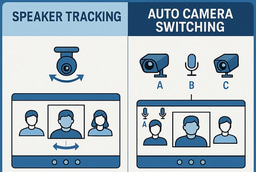Understanding Signal Interference and Its Impact on AV Systems

To this day, many electrical MEP engineers overlook or underestimate the importance of AV design recommendations particularly those related to signal interference. Unfortunately, this oversight can have a direct impact on the performance and reliability of AV systems. Poor coordination during the design or installation phase can result in noise, signal degradation and even complete system failure.
That's why I’ve decided to share some insightful information about signal interference, how it affects AV systems and best practices to prevent it.
What is Signal Interference? And should we know about it ?
Signal interference is a common and often frustrating issue in audio/video (AV) systems. It occurs when unwanted signals disrupt or degrade the intended signal, leading to poor performance, distorted sound and compromised video quality. Understanding the types of interference, their sources and how they affect AV setups is key to preventing and resolving these problems.
Signal interference generally falls into three major categories: Electromagnetic Interference (EMI), Crosstalk and Radio Frequency Interference (RFI).
First Type, EMI is the improper operation of a circuit due to external electric or magnetic fields. These fields can be generated by everyday electrical devices and can induce unwanted noise in nearby cables or components.
How and Why It Happens:
Electricity flowing through a conductor creates a magnetic field. When this field comes in close proximity to another conductor carrying a weak signal (such as an audio or video cable), it can induce unwanted voltage or current, degrading the signal quality.
Common EMI Sources:
- Power cables
- Electric motors
- Transformers
- Fluorescent lights
- Dimmer switches
So the first important question that AV designers/installed need to take into consideration is: How to Prevent EMI in AV Installations ?
1. Use Shielded Cables
- Choose shielded twisted pair (STP) or foil-shielded cables for AV, especially in areas with electrical noise.
- For HDMI, USB, audio and control lines, go for high-quality, double-shielded cables.
- Ensure that the shielding is grounded properly at one end (or both if designed that way).
2. Maintain Physical Separation
- Route AV signal cables away from power cables—ideally at least 12 inches apart.
- If they must cross, do so at a 90-degree angle to reduce coupling of the magnetic field.
3. Avoid Running AV Cables Near EMI Sources and Keep signal cables away from:
- Electrical panels
- Transformers
- Fluorescent or LED lighting ballasts
- Dimmer switches
- Electric motors (HVAC units, elevators, etc.)
4. Proper Grounding and Bonding
- Ensure all AV components are properly grounded to prevent ground loops and floating voltage issues.
- Use a single grounding point to avoid voltage differences across equipment.
5. Ferrite Beads and Chokes
- Attach ferrite cores to signal cables, especially for HDMI, USB and analog audio.
- They suppress high-frequency EMI and help clean up the signal.
6. Use Isolated Power Sources
- Plug sensitive AV equipment into clean power sources (dedicated circuits or isolated power conditioners).
- Avoid sharing outlets with heavy electrical loads.
7. Use Quality Equipment and Installation Practices
- Avoid low-quality extenders, adapters and splitters—they often lack proper shielding.
- Follow best practices for cable dressing and routing—no sharp bends, no cable kinks, no over-bundling.
8. Enclosures and Conduits
- Use metal conduit or EMI-rated enclosures for signal cables in high-interference environments.
- For critical installs, consider using fiber optic cables—they are immune to EMI.
2nd Type is Crosstalk , it occurs when a signal transmitted on one circuit or cable causes an undesired effect on another, usually through electromagnetic coupling between nearby wires.
Mainly it is Common in Category (CAT) cables, particularly in structured cabling systems for AV-over-IP or networked AV environments.
Types of Crosstalk:
- Near-End Crosstalk (NEXT): Detected near the transmitter end.
- Far-End Crosstalk (FEXT): Detected at the far end of the cable, opposite the transmitter.
- Alien Crosstalk (AXT): Caused by signals from adjacent cables rather than within the same cable. More likely when high-voltage and low-voltage cables are bundled together or cables run near interference sources like fluorescent fixtures.
So What It Is Best Practices to Prevent Crosstalk ?
1. Use Proper Termination Techniques
- Always follow manufacturer termination guidelines for connectors and patch panels.
- Keep twist rates in place right up to the point of termination.
- Use verified punch-down tools to ensure firm and consistent connections.
2. Minimize Untwisting of Pairs
- Do not untwist more than ½ inch (13mm) of the twisted pairs at termination points.
- Maintain twist integrity to preserve the cable’s natural resistance to electromagnetic interference.
3. Preserve the Cable Jacket
- Remove only as much jacket as necessary—exposing too much conductor increases susceptibility to crosstalk.
- Avoid damaging the cable when stripping; nicks and cuts can introduce performance issues.
4. Avoid Tight Bundling
- Don’t over-tighten cable bundles or use zip ties that compress cables.
- Use Velcro straps or loosely grouped bundles to reduce coupling.
5. Maintain Distance from High-Interference Sources by Keeping Cat cables away from:
- Power cables
- Fluorescent lighting
- Electric motors or transformers
- And use separate cable pathways or raceways for low-voltage and high-voltage runs.
6. Choose High-Quality Cables and Components
- Use certified Cat6A or Cat7 cables that provide better shielding and performance against crosstalk.
- For high-density installations, consider shielded twisted pair (STP) instead of UTP.
Last Type is RFI, it’s a type of EMI that occurs at radio frequencies. It happens when unwanted radiated signals travel through the air and enter signal paths, especially affecting wireless and digital communications.
How and Why It Happens:
Radiated signals from electronic devices can be picked up by nearby cables, antennas or circuits.
This external RF noise disrupts the intended signal path, causing interference, audio distortion or video degradation.
Common RFI Sources:
- Wireless phones and devices
- Wi-Fi routers
- Bluetooth devices
- Fluorescent lighting
- Power lines
Last important aspect that AV designers and installers must keep in mind is: What is the Best Practices to Prevent RFI
1. Use Shielded Cables
- Use shielded cables (such as STP or foil-shielded cables) for critical signal paths, especially in environments with a high concentration of RFI sources.
- Ensure shielding is properly grounded at both ends to reduce the possibility of RFI penetration.
2. Position Equipment Strategically
- Physically separate sensitive AV equipment (like cables, receivers and antennas) from sources of RFI.
- Maintain distance between wireless devices, Wi-Fi routers and AV equipment.
3. Install Ferrite Beads and Chokes
- Attach ferrite cores or RFI chokes to cables to suppress high-frequency signals and reduce RFI from entering cables.
- This is especially helpful for HDMI, USB and audio cables.
4. Use Proper Grounding and Shielding for Equipment
- Ensure that all AV equipment is properly grounded to avoid picking up unwanted RFI from surrounding electronic devices.
- Use shielded enclosures or metal enclosures for sensitive devices to block external RFI sources.
5. Control the Placement of Wireless Devices
- Place wireless devices (e.g., Wi-Fi routers, Bluetooth transmitters) away from the AV system.
- If possible, limit the use of wireless devices in AV spaces or use wired alternatives when possible.
6. Upgrade or Replace RFI-Emitting Components
- Avoid using older fluorescent lighting or cheap power strips, as they can act as significant sources of RFI.
- Replace outdated devices with RFI-friendly, modern alternatives that are designed to reduce signal interference.
7. Use Low-Interference Power Supply
- Plug AV equipment into clean, isolated power sources to prevent RFI from power lines and transformers from affecting your system.
- Use power conditioners to clean up power signals and reduce noise.
MEP Engineers need to know How Signal Interference Affects AV Systems !
Signal interference can cause a variety of AV issues depending on whether it impacts audio, video or both:
Audio Interference Effects
- Buzzing or humming sounds: Often caused by EMI or ground loops, especially near transformers or dimmers.
- Audio dropouts: Caused by interrupted digital audio signals or crosstalk.
- Distortion: Signals may sound fuzzy or crackly due to noise contamination.
Video Interference Effects
- Flickering or lines on the screen: Common in analog video setups affected by EMI.
- Pixelation or digital artifacts: Crosstalk and signal degradation in digital signals (e.g., HDMI) can result in blocks or glitches.
- Loss of signal: Severe interference can overwhelm a weak video signal, causing a complete signal loss or "No Signal" display.
Finally ,I hope I haven’t made this too monotonous ; So I conclude that Signal interference whether from EMI, RFI or crosstalk can significantly degrade the performance of Audio and Video systems in both residential and commercial environments. By acknowledging the importance of AV recommendations and implementing smart design and installation practices, electrical and MEP engineers can ensure high-quality, interference-free AV performance.
What are some of the most common signal interference challenges you’ve encountered in your AV projects and what strategies have you found most effective in addressing them?
-
Xchange Advocates are recognized AV/IT industry thought leaders and influencers. We invite you to connect with them and follow their activity across the community as they offer valuable insights and expertise while advocating for and building awareness of the AV industry.





Please sign in or register for FREE
If you are a registered user on AVIXA Xchange, please sign in
Bookmarking this for future reference!
Some of this "sounds" like what I recently experienced in a system I installed comprised of Sennheiser wireless microphones, Dante AVIO, POE/Dante ceiling speakers and NDI devices. The system was fine until a 4 input XLR extender over Cat6 (Cable Matters) was added. There would be noise coming from the speakers anytime mics were disconnected from the Tx device. Ultimately, I advised the client to mute the respective channel(s) on the mixer before disconnecting any microphones from the Tx device and keeping said channel(s) muted until a microphone is connected to the XLR.